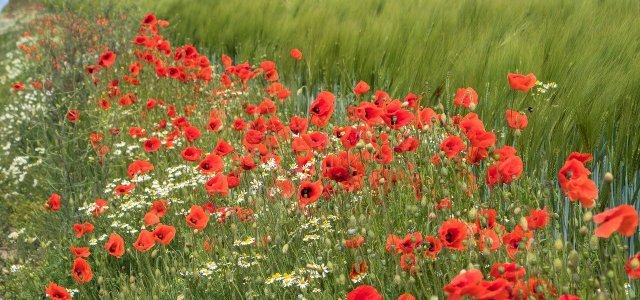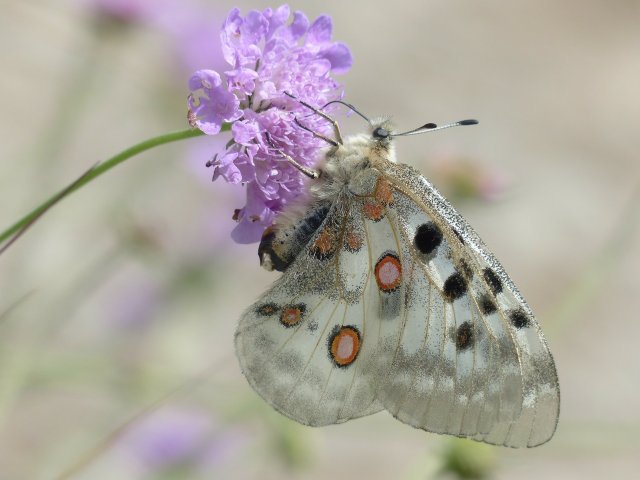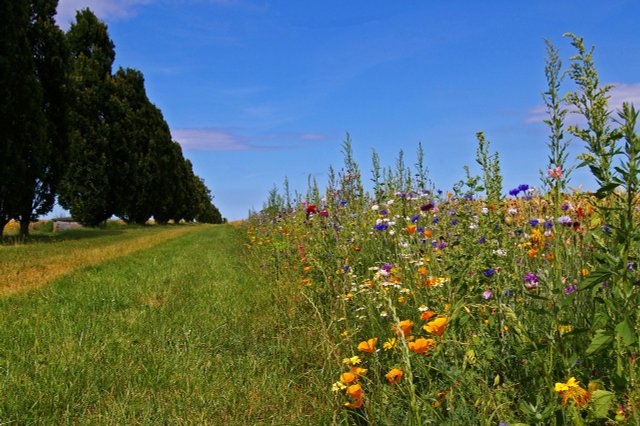
Flower strips promote biodiversity in fields and gardens through flowers and wild herbs. Why this is so, why it is so important and how you can create and maintain flower strips yourself, you can read here.
Contents
Flower strips: Endangered habitats
Flower strips refer to field margins where blooming flowers and herbs grow. A sight that was completely commonplace just a few decades ago. Today, these colorful field margins are in danger of disappearing more and more.
Industrial agriculture and a high consumption of pesticides mean that fewer and fewer plants and animals find their habitat at the edges. Too much fertilizer in the fields can also harm the wild field margins. Some of them depend on nutrient-poor soils and cannot cope with the overabundance caused by fertilizer.
NABU reports that the number of species of wild weeds in cultivated fields has declined by up to 95 percent in some cases. Often, only five to seven different species can be counted in a field. This limits the habitat for many animal species such as insects, reptiles or birds. Some of them are even severely endangered as a result, for example the wild bee.
NABU is therefore calling for flower strips to be protected and for new strips to continue to be planted around fields.
More than just flowers disappear with the flower strips

Flowering field margins and environmentally sound agriculture belong together. This is how NABU argues that flowering strips fulfill important tasks in agriculture.
- Biological pest control: Insects live in the flowering strips and feed on the pests in the fields. As a result, agriculture can use fewer pesticides or even dispense with the chemicals altogether.
- Pollination: insects pollinate the flowers and thus help to secure the harvest.
- Erosion control: flower strips or wild hedges act as wind breaks between fields. Without them, the wind carries fertile soil away from the field. In extreme cases, this can make agricultural land infertile.
The National Association for the Protection of Birds lists other functions with which flowering strips contribute to biodiversity.
- Food: The seeds of many wild herbs provide food for birds, among other things.
- Habitat: The grasses and small shrubs provide shelter for reptiles and small mammals. Native birds such as skylarks and partridges find protected nesting sites.
- Protection in winter: The densely vegetated strips protect the ground from frost and snow. Small animals take up quarters here in winter.
- Connection to other habitats: The flower strips are connecting paths where animals can move around under the protection of the plants.
- Retreats from humans: Animals can take refuge in the strips at the edge of fields when tractors and harvesters are in use.
Flowering strips in agriculture

The EU support program for agriculture has also been supporting flower strips for several years. As part of the “Common Agricultural Policy of the EU” (CAP for short), farms receive funding. Farmers who want to re-establish flower strips receive support. However, they have to comply with some requirements.
Important! The seeds used must come from native plants. The seed mixture is specified for each region. This means that the plants are adapted to the insects and soil found there. Only in this way can the flowering strips fulfill their function as a source of food. If the insect does not find the right type of flower, it cannot simply switch to the nectar of another species. Flower and insect are usually perfectly attuned to each other.
However, NABU criticizes the fact that the current funding is too complicated, bureaucratic and not always targeted. The environmental organization sees an opportunity for fundamental reform in the current negotiations for the new EU funding period 2021 to 2027. Agriculture should take greater account of environmental protection and promote biodiversity, for example with flowering strips.
“Flowering strips” also have a place in the garden or on the balcony

You can also promote native species protection through flower strips at home. You have a lawn in your garden? Great, just leave the lawn mower alone. It also helps if you allow wild growth in one corner. In the spring or fall, simply scatter mixed seeds of wildflowers there. If you don’t have a garden, you can also create a balcony garden where wildflowers can grow. Make sure that you sow native flowers.
In addition to food, insects also need a water trough. A plate with stones or corks is often enough for this. Also remember to provide nesting sites for the insects: For example, you can easily build an insect hotel yourself.
For example, let nettles or thistles grow when you plant a flowering strip in your garden. Tip: Nettles are a local superfood and really healthy.

